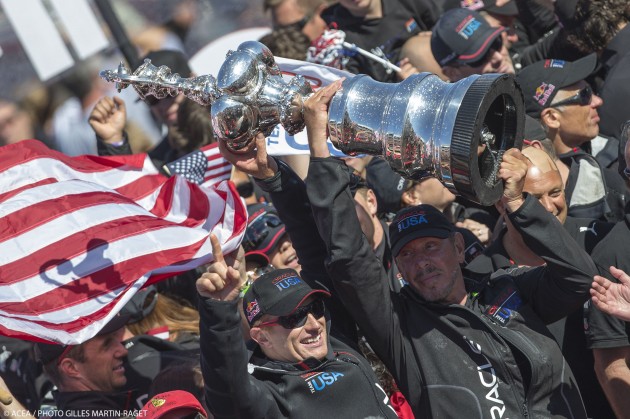And why the Kiwis lost, along with hints of the future for the America’s Cup
The speed with which the 34th Cup is being dismantled feels as swift and dramatic as the final race that sealed the biggest comeback in sailing. Walls have been pulled down, banners removed, stages collapsed and the impressive line up of Superyachts at Pier 29 disappeared overnight.
The crowds of overseas visitors that flooded down to the official parks and the sea front locations have now moved to the airports and freeways as they scramble to get out of town before the mass exodus from the city at the end of the Oracle Openworld conference.
The last 24 hours has provided a brief period of speculation and reflection. Top of the list for the former is who the next Challenger of Record might be.
Until last night it was widely believed that the Swedish Yacht Club KSSS, represented by Artemis Racing would be the COR in the event of Oracle winning the Cup. But it sounds like that might not be the case, at least not yet. Instead there has been talk of an Australian club or even a Canadian club taking on this role, at least until the Swedish club and dot the ‘I’s and cross the ‘T’s.
There is even talk of the Swiss yacht club Society Nautique de Geneve being involved, but given Russell Coutts’ poor relationship with Alinghi’s Ernesto Bertarelli it would seem unlikely. More realistic is the possibility of Alinghi returning as a Challenger. But who might they have as their skipper? Brad Butterworth was in town for the early part of the Cup was he checking out the landscape or talent scouting? If so, could Ben Ainslie could be on the team’s wish list?
As to whether the Cup would come back to San Francisco, Larry Ellison was tight lipped at the press conference as to what the plans were for the Cup, it’s location and format.
But above all else, the chatter that is still doing the rounds is how Oracle managed to find such a big step up in performance. The Kiwi press is focusing on the Stability Augmentation System (SAS) that is believed to be on Oracle’s cat that helps with accurate trim of the foils. The trouble is that while there are plenty of examples of where this is commonly used in aviation, no one knows what the American team had aboard their boat – if indeed they did.
For what it’s worth, I don’t believe the SAS was the key component in Oracle’s eventual invincible performance. Sure, it may have contributed, but for my money Oracle entered the event with a more refined boat with lower drag foils but that was more difficult to sail, especially with the set up that the home team began with. Even on the last race we saw Spithill plunge the boat underwater as the black cat fell off her foils. So much for a system that kept the boat on the boil all the time.
Shocked by the upwind performance of the Kiwis, Oracle is more likely to have set about establishing why Team New Zealand was quick as well as doing all they could to catch up on the crew manoeuvres. The former meant looking at their set up, the latter meant studying videos and figuring out what they were doing wrong.
Talented people of the caliber that Oracle Team USA hired didn’t take long to figure out how to alter the settings to make the boat pop up on its foils once they had a datum to work to. As if finding a new set of sprockets on a racing bike, or tweaking the trim tab on a model plane, the team found some big potential gains without plugging in the big power tools.
Emirates Team New Zealand on the other hand had sailed more days than anyone else and had squeezed pretty much every last drop of performance out of their boat by the time they arrived at the start of the event.
A few days into the series, team COO Kevin Shoebridge told me that in 2007 they had locked down the design development of the boat two before months before the event. Here they were still adjusting and tweaking days before, it was a policy decision after the team had recognised the failing in Valencia.
Oracle was doing it on the hoof.
But another reason the Cup stayed north rather than going south was a big mistake by the Kiwis on the 16th Sept. Unfortunately this is now clearer in hindsight, but the Kiwis had agreed with Oracle that this reserve day would be changed to a no race day. As the results now show, at this point the Kiwis were still on a roll and Oracle on the verge of a step change in performance.
The next race that the Kiwis sailed was the last that they won. From then it was one way traffic through to the biggest comeback in sailing.
Aside from the outcome for the teams, the Cup itself performed a staggering comeback. From a controversial start, tragedy, commercial short comings and a lack of challengers came the most extraordinary and vibrant Cup for 30 years.
The irony for the Cup itself was that the weak and poorly attended Challenger series resulted in the biggest reminder yet as to what the America’s Cup is all about – Challenger versus Defender – a message that got lost in the two previous multi challenger America’s Cups.
The trouble is that one makes money and the other makes a lot of noise. Combining the two will be the challenge for next time.




